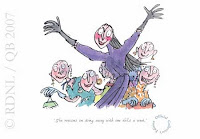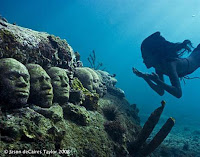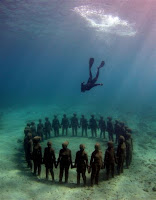Here is what is hopefully a good review of the sources I was reading. I would have liked to have put some images into the text, however the source 'Learning from the Japanese City:West Meets East in Urban Design' is no longer available on the netlibrary, i have to have an 'Athens' password and user name :(. . .thankfully this happened after I had read and looked through all of it! Except the images I would have liked to put in, everything else is there:
I have researched into Subway Design, learning about the need to improve the general atmosphere and congestion problems of train stations, also investigating into rail stations links to crime. This led me to take an interest in other cultures, delving into learning about ‘The Japanese City’ and how the Japanese way of life could give the Western world some inspiration on seeing design in a different way.
The first Journal of relevant information I came across was ‘The International Journal of Transport Management 1 (2003) 121-132: Managing Crime and Fear of Crime at railway stations - a case studying South Wales (UK)’ which brings forward evidence that the general public’s perception of personal crime in the station and in the vicinity of railway stations are much higher than statistics show, discouraging them for using trains.
The article also analyses and discusses railway safety and accessibility, surveying a select number of the public’s ‘Cartography of fear and Crime’ (Cozens, 2003:128). Introducing a new solution using Crime Prevention Through Environmental Design (CPTED) was tested using a VR (Virtual Reality Interaction) which provides a walk-through ‘panoramic’ view of the station. Six different stimulus stations were shown to each person being surveyed. A constructed questionnaire then completed by the candidates; results were then used in finding needs for improvisations of the railway stations.
Having also looked into other subway systems such as the NYC Subway, one of the busiest undergrounds in the world (4.5 million passengers a day ‘www.web-japan.com’) my attention then turned to the Tokyo Subway which takes around 7.2 million passengers to their destination everyday. Whilst researching on the internet for pictures, videos, something to give me a good impression of what a Japanese train station looked liked and how it worked, I discovered that their subways are a carefully fabricated system. Images showed a clean, environmentally friendly, organised form of transport.
If the Japanese population can have a safer subway system, surely the Western world can learn/borrow from their continuously modernising culture? Which led me onto my next source: ‘Learning from the Japanese City: West Meets East in Urban Design’ Shelton B.1999. In this source the author sets the question: ‘Why do Japanese cities look the way they do?’ Shelton gives the reader a sense of the Japanese city in comparison to Western Design culture through his own research and own experiences.
The main information in Source 1 is the study findings. The graph shown in the article is backed up by the people’s surveyed answers: “I wouldn’t like to walk down there, if I was on my own, especially after dark.” (Female Respondent 3, (F3) Station Family Group 3 (SF3). Can the station be improved by using CPTED and VR to provide a safer, cleaner and more accessible public transport?
In my research I also came across a journal of ‘Research in Crime and Delinquency’ Giblin Matthew.J. (2008) which examined Personal Security and Avoidance Measures, using a similar survey to Source 1, to show their findings. Studies show that depending on age, race, sex and marital status, those within the general public are more likely or less likely to avoid a certain area of a city.
As it is similar to the case study in source 1, if the CPTED can give as much information to the public as possible, collecting an honest view of what should be improved to make rail stations better, and make rail users safer and feel much safer would be incredibly useful. A huge improvement.
“Although times are changing, Japan is still a remarkably honest country and if you lose something on a train or in a station, there is a very good chance that someone will turn it into the lost and found.” www.japanrail.com A country well known for it’s etiquette, honesty and a low crime rate (about half as many crimes committed compared to the U.S. figure) -M.O.F.A. (Ministry of Foreign Affairs) the author of Source 2, Shelton, explains that as a country Japan look at Design in a completely different way for the West, including the way cities are built. In the 1950-60s visitors admired Osaka for ex. it’s ‘extensive grids of streets and Spaciousness (Shelton;1999) However Westerners did not entirely appreciate or were so impressed Japan’s Urban Culture, to most it was found to be grey, drab and featureless (Morse:1972, 1-6). Throughout history, Shelton goes onto explain; that most Japanese streets and houses are thought out in an equal manor, persons within an affluent area would build a house around or in a grand garden rather than being based on grand features for example, which is what Westerners are general more used to seeing.
Shelton believes that as much as Western architecture is influenced by other cultures, it also has a long standing hierarchal history, which we need to move away from. Where as the Japanese live by the ‘content’. This is possibly the best secondary source I found in the text to explain Shelton’s context further:
“The Japanese language and culture have certain flexibility in them. In the field of philosophy it is believed, in European languages and thought that at the centre of things reside God. . . So there exists such a centre at some point, by which everything is controlled. In other words the whole can be universal. . . A place (in Japan) is originally designed as an empty place into which anything may be brought. The way of interrogation is not that the centre holds everything together, but rather only that there exists co-ordination at some point but with nothing inside it.” (Nakamura:1984, Process Architecture, 49, 62-63).
Looking back on Source 1, the survey includes 6 chosen railway stations picked within areas of a different status, deprived, affluent, etc. Europe it seems goes from one extreme to the other, whilst a Japanese City is mostly middle ground. I would agree with Source 2 in saying that the Western world’s cities and towns are based around religion; most cities around the U.K. for example, are cities because they have a cathedral. Houses in these areas near the centre are bigger, grander, as you move further away from the area to the edges of the city, houses are smaller, plainer, and in deprived areas.
Why do immediate access entrances to subways in this country tend to be in a ‘deprived’ area? I don’t think the answer would be to move the entrance, but perhaps illuminate the area. The findings show in Source 1, that the main suggestions for improvisation after viewing the CPTED were; much better lighting for stations at night. Despite the VRs being show were shot in the daytime, more and more people picked up on and suggested better lighting. Including these were more CCTV, working staff and a cleaner station.
Source 1’s main assumption seems to be that the public’s ‘fear’ will be gone after installing more lights. Railway stations are quite ominous at night from my own experience, more CCTV, cleaning and staffing would improve customer safety: “Cleaning up the stations automatically makes it feel a safer place” (M3, SF4). “If you take away those bushes and trees you could be seen by motorists” (F2, SF6) “People feel safer on a station that other people can see (F2, SF3)
In comparison with Source 1, Source 2’s main assumptions are that living in the Western world where cities are built by context, is a bad thing. . I agree that accounting for every street, building and house in a city is an important subject; however Europe should be proud of their amazing historical architecture.
Buildings in Europe have great stories behind them; Western culture I believe is rich and interesting. Japanese buildings do not have this same history but a completely different interest.
A key secondary source in Source 2 in this text is images by Hiroshige, Nihonbashi and Edobashi. They are examples of the Japanese focus of one fragment of an object looked at closely, for the expense of the whole thing. ‘Incompleteness is the natural order”. (Shelton .B 1999:175).
After reading and thoroughly taking in the information of these two sources I do think that more attention should be paid to deprived areas in the U.K, housing as well as railway stations. I feel that the author of Source 2 is a little biased in his opinions, almost saying that the East and better than the West; having said that, this statement I may agree with: “Now it may be the cities turn and I am one of a small but growing band of designers and planners who are setting their sights in an Easterly direction.’ (Shelton.B:1999, 189). This is one of the author’s main conclusions in the article; Shelton also insists that the Japanese cities buildings are more ready to be built on in/for the future than the West’s.
I am not in complete agreement with Shelton, I believe that borrowing or perhaps ‘stealing’ ideas from another culture, particularly the Japanese could however be very successful.
A safer subway made me also think about crime and vandalism within these areas, I think that if we made for instance graffiti art a trend, it could catch on even more-so than it has done already. “Featuring artwork from more than 20 cities around the world, this book chronicles the evolution and development of the art form from it’s beginnings on subway cars to it’s acceptance into art galleries.” Why not use what we recognise as vandalism to our advantage and make a street-art form part of our culture? This would make subways more interesting and individual at least.
Both of these sources have given me relevant information on improving through designing, surveying, and the author’s self-experiences.
Source 1’s survey and case study led to a “£2.5 million grant” from the Welsh Assembly to improve the stations, notably ‘The Wales and Borders Trains (2003). This shows a success in their use of CPTED. Evidence of past usage of the same format comes from ‘The Parliamentary Travel Safe Committee in Brisbane Australia’ providing a ‘variety of potential solutions designed to reduce recorded crime rates in the railway environment’. I think CPTED could be used more frequently in the present, the future and for other uses such as bus stations, airports, etc.
Source 2 demonstrates a new way of seeing and thinking about the design of a city. Although slightly biased, I see the importance of looking at the bigger picture; looking beyond a building, a bridge: looking at a whole area/space and analysing it.
Shelton demonstrates the contrasts in Eastern and Western Culture by comparing two children’s magazines: Fig 2.9 ‘A Japanese children’s magazine cover a collage of large and small things which enjoy some kind of visual equality over the whole surface of the page’ (Tanoshii Yochien, Issue 10, 1995) Fig. 2.10 is a cover of a children’s English language magazine Thomas the Tank Engine. ‘This cover shows an altogether simpler more heriarchial order.’
Our cultures differentiate us; we should be able to borrow from other cultures without stealing from them completely. This source (2) supports the idea that the Western world may need to move forward even more-so in design, to make a more secure, cleaner, friendlier place to be. Source 1 supports evidence that this is so in the design of public transport.





